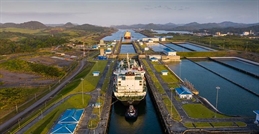
The Panama Canal closed its fiscal year 2021 (FY21) with a record-breaking annual tonnage of 516.7 million Panama Canal tons (PC/UMS), coming in 8.7% higher compared to the 2020 fiscal year (FY20) and 10% above tonnage registered in FY19, the waterway’s last pre-pandemic fiscal year.
In a statement, the waterway noted how 2021 was marked by unprecedented supply chain challenges caused by the continued impact of the COVID-19 pandemic.
"Related disruptions drove container rates to rise exponentially and production to slow down across various sectors, due to raw material shortages. Amid this landscape, the Panama Canal saw traffic grow between October 1, 2020 and September 30, 2021, driven by liquefied natural gas (LNG), liquefied petroleum gas (LPG), containerships, dry bulkers, and vehicle carriers," it said.
"Containerships continue to reflect a surge in demand for finished consumer products, as increased purchases during the pandemic stressed supply chains and caused congestion in ports worldwide."
Growth led by LNG carriers
Panama Canal said LNG carriers registered a 31.4% increase in tonnage through the Panama Canal, representing the largest gain across all segments. LNG also set new annual records for total tonnage and transits, in addition to monthly tonnage and transit records in January 2021, fueled by record winter temperatures in Asia.
It said more LNG terminals located in in the Gulf Coast and the East Coast of the U.S. expanded their operations, spurring an increase in exports shipped to Asia.
"LNG is not only growing the fastest, but it has had its best year in terms of tonnage through the Canal," said Ilya Espino de Marotta, deputy administrator of the Panama Canal.
"However, this year’s figures across segments demonstrate the Canal can adapt and meet fluctuating market needs, as shown earlier this year, when we modified the Panama Canal reservation system to offer our customers additional booking options and flexibility."
The main trade routes using the Panama Canal by tonnage in FY21 included the U.S. East Coast – Asia, followed by the U.S. East Coast – West Coast of South America, West Coast of South America – Europe, South America Intercoastal, and the East Coast South America – Asia route, the latter of which replaced the East Coast U.S. – West Coast of Central America route in the Canal’s top five routes.
It said South Korea also moved up the ranks to become the fourth top user of the waterway this year, preceded by the United States, China, and Japan, with Chile coming in fifth.
All in all, the waterway said it recorded a total of 13,342 transits in FY21, driven by an increase in Neopanamax transits.




